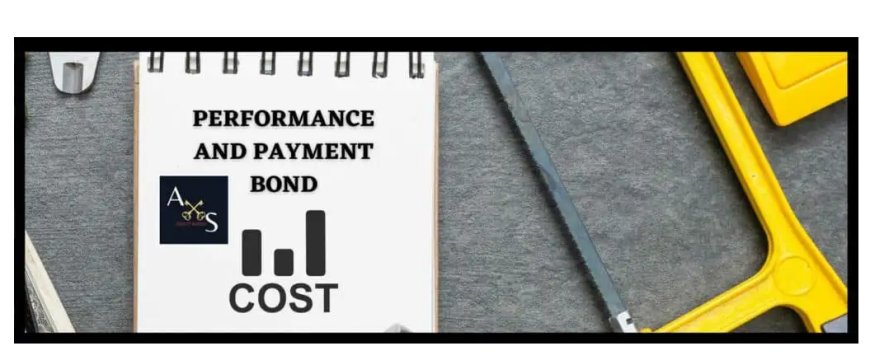What Really Affects Performance Bond Pricing Today
This blog breaks down what actually shapes performance bond pricing today, especially the factors that often get overlooked. If you’ve ever wondered why two bids with similar numbers get different bond quotes, keep reading. This will make things clearer.

Getting a performance bond isnt just about ticking a box for project approval but is a part of how you're judged before the work even starts. Many contractors assume there's a standard price tag for bonding, but thats far from the case. Prices can shift based on a handful of variables, some obvious, others less so.
This blog breaks down what actually shapes performance bond pricing today, especially the factors that often get overlooked. If youve ever wondered why two bids with similar numbers get different bond quotes, keep reading. This will make things clearer.
The Basics Most People Already Know
A performance bond is a financial guarantee. It promises that youll complete a job as agreed, and if you dont, the surety steps in to protect the project owner. You usually pay a small percentage of the contract value to get the bond, often between 0.5% and 3%.
Most people expect pricing to depend on contract size or overall business volume. Thats true, to a point. But many other pieces of the puzzle matter just as much, some even more.
Performance Bond Pricing and Your Business Track Record
One of the biggest things that affects performance bond pricing is how youve handled past projects. If youve finished jobs on time, stayed within budget, and avoided bond claims, youll likely get better rates. Sureties look at how youve managed similar jobs in the past, not just your total revenue.
Your financials matter, too. Bonding companies review your working capital, cash flow, and debt. If your books show stability, that helps lower your cost. They also want to see that you have the right licenses, insurance, and staffing in place for the size and type of work youre bidding on.
So, while the project youre bidding on may look straightforward, the surety will still want to know how youve handled jobs like it before and how you manage your business overall.
The Bigger Market Also Shapes the Cost
You can do everything right and still see pricing change. Thats because performance bond rates are also tied to larger market conditions.
For example, if interest rates rise or the surety market tightens, prices across the board may go up. Economic uncertainty can make surety providers more cautious. They might raise rates or reduce capacity in certain sectors. You might feel this even if your own record hasnt changed.
In short, the market mood matters. Pricing isn't just about you but also about how sureties are balancing risk across industries.
The Type of Project Youre Bidding on Matters
Not all projects carry the same risk. A large public highway job, for instance, comes with different expectations than a small commercial build. The more complex the project, the more likely the bond rate will reflect that added risk.
Jobs that involve multiple subs, custom materials, or unusual conditions can affect the price, too. Design-build projects often involve more coordination and can raise eyebrows with underwriters who dont want surprises.
Even if your contract amount is the same, a jobs scope and setup can push the price up or down.
Where You Work Can Influence Pricing
Bonding rules and requirements dont always look the same across state lines. Some states or regions have a history of more frequent bond claims, which can affect pricing in those areas.
Local laws and contract rules can also change how sureties view the risk. If your business operates in several states, you might notice your pricing looks different depending on the location of each job.
Knowing how bonding works where you're working can help you plan and price smarter.
Your Surety Relationship Makes a Difference
Bonding isnt like ordering supplies. It works better when you have an ongoing relationship. If you work with the same surety or broker consistently, theyre more likely to understand how you operate and trust your numbers.
That trust can help reduce your rate over time. Sureties dont just assess risk from your financials; they also assess how predictable and prepared you are. If youve built a good track record with them, theyll usually offer better terms.
On the flip side, bouncing between sureties can make it harder to show stability.
What You Can Do to Improve Your Pricing
Theres no magic button to lower your bond costs, but there are things you can control. Keeping clean, up-to-date financials is a big one. Many contractors miss out on better pricing simply because their paperwork is out of date or incomplete.
It also helps to share your upcoming workload with your surety, especially if youre planning to grow. They can give you input before you submit a bid, which helps prevent issues down the road.
Working with a surety who knows your field, like public works, specialty trades, or large-scale infrastructure, can also help shape better pricing. The more they understand your day-to-day, the more confident theyll feel about supporting you.
Conclusion
Performance bond pricing is shaped by the story behind your business, the work you take on, and the current economic climate. When you understand these moving parts, youre better equipped to respond, adjust, and improve over time.
As public and private jobs become more selective, knowing how to work with bonding partners, not just through them, will give you an edge. You dont need to guess what the bond will cost if youve taken the time to understand whats driving the quote. And in a shifting market, that insight is worth a lot more than a one-time low rate.





































